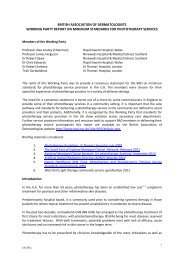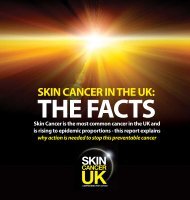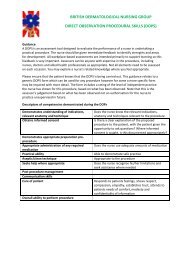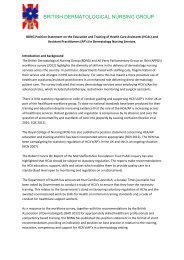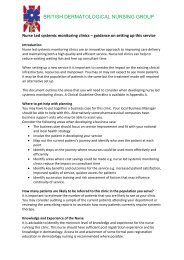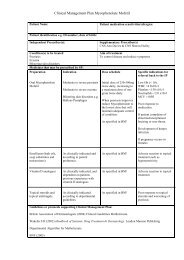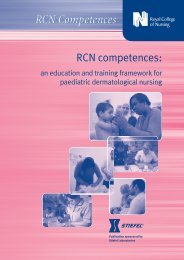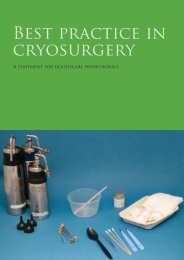Improving outcomes for people with skin tumours including melanoma
Improving outcomes for people with skin tumours including melanoma
Improving outcomes for people with skin tumours including melanoma
Create successful ePaper yourself
Turn your PDF publications into a flip-book with our unique Google optimized e-Paper software.
<strong>Improving</strong> Outcomes <strong>for</strong><br />
People <strong>with</strong> Skin Tumours<br />
<strong>including</strong> Melanoma<br />
Management of special<br />
groups<br />
Management of<br />
special groups<br />
Introduction<br />
Patients who are immunocompromised or who have a genetic<br />
predisposition are at increased risk of developing <strong>skin</strong> cancers. They<br />
are likely to develop precancerous lesions and cancers at a younger<br />
age and to develop multiple primaries. These patients and others <strong>with</strong><br />
rare <strong>skin</strong> <strong>tumours</strong> (Appendix 1) may need more investigations, more<br />
intensive, earlier follow-up and specific, supportive care and<br />
in<strong>for</strong>mation. Another group <strong>with</strong> special additional needs are children<br />
and young <strong>people</strong> <strong>with</strong> ‘adult-type’ <strong>skin</strong> cancers.<br />
6<br />
Genetic predisposition<br />
There are a number of genetic conditions associated <strong>with</strong> the<br />
development of multiple <strong>skin</strong> cancers earlier in life than in the general<br />
population. The most common are described below.<br />
The commonest genetic condition that predisposes to BCC is the basal<br />
cell naevus syndrome (Gorlin’s syndrome), which is estimated to<br />
occur in 1 in 57,000 of the population. This is inherited as an<br />
autosomal dominant condition <strong>with</strong> a high spontaneous mutation rate.<br />
Affected individuals often have bony anomalies and dental cysts. In<br />
adult life they are at increased risk of BCC although BCCs can<br />
develop at very much younger ages. This risk is increased by<br />
exposure to irradiation, which must there<strong>for</strong>e be avoided. Sun<br />
avoidance throughout life should be promoted to prevent <strong>skin</strong> cancer.<br />
Xeroderma pigmentosum (XP) is a rare autosomal recessive disorder.<br />
The estimated frequency is one case per 250,000 population in the<br />
United States and Europe. Within the first few years of life, BCC, SCC,<br />
sarcomas and MM start to develop if sun protection does not occur.<br />
112<br />
National Institute <strong>for</strong> Health and Clinical Excellence




